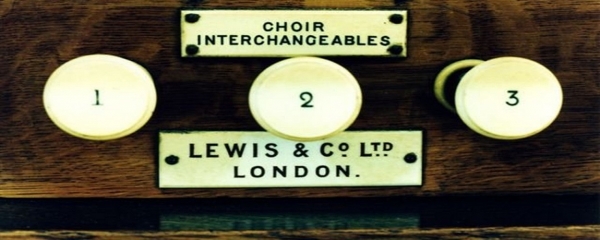Thomas Christopher Lewis | La vita e l'arte
Thomas Christopher Lewis was among the leading organbuilders in the late 19th century Britain and achieved wide fame for the tonal and constructional excellence of his instruments. His works represent a personal synthesis of modern German and French tonalities within an English framework.
He was born in London in 1833. his initial training was as an architect and he remained on friendly terms with many of the leading architects of the time, particularly J.F. Bentley, designer of Westminster Cathedral and of numerous organ cases for Lewis's instruments. In 1868 Lewis established a factory at Brixton, in South London, gathering together a large team of skilled workers. The total number of organs built by the firm before 1900 is thought to be more than 600.
For some years Lewis had made a special study of the organbuilding work of Schulze, the small instrument sent from the factory in Paulinzelle (Germany) for display at the 1851 London Exhibition and particularly the ne organ at Doncaster Parish Church. From Schulze was derived a predilection towards copiously winded flue choruses of great brilliance and power and the use of Germanic registers such as the Geigen Principal, Flauto Traverso, Lieblich Gedackt e Rohr Flöte.
A further important contribution to his evolving style came from Aristide Cavaillé-Coll. He set harmonic flutes, strings and chorus-orchestral reeds derived from French practice.
Moreover his practice was diametrically opposed to that of the other great individualist of the laternineteenth century, Henry Willis, and there was a conscious rivalry. The depth of their disagreement is revealed in Lewis’s pamphlet “A protes against the modern developement of unmusical tone” (1897) in which – without naming his rival – he takes issue with many of the distinguishing features of Willis’s practice: high-pressures, hight cut-ups, slotting, “insipidly smooth” reeds, tierce mixtures…
Unfortunately very few of Lewis's larger instruments survive intact and have not escaped the desire of later generations to alter, enlarge or 'improve' them, his continental palette of sound proving unacceptable to the generation of the inter-war period. His use of chorus reeds of free, blending quality on low wind pressure was derided by writers such as George Dixon. Many organs, too, were destroyed during the second world war, especially in the suburbs of London.
The organ of Southwark Cathedral in London built in 1897 – one of the thoroughbred instrument which has remained basically unaltered in its original tonal structure – is Lewis’s chef d’ouvre, as well the organ of Kelvingrove Art Gallery in Glasgow and the St Paul's Cathedral organ in Melbourne (Australia). His commissions include the cathedrals of Ripon, Newcastle (Anglican and Roman Catholic), Southwark and Westminster, St Andrew's Hall, Glasgow, and many of the major churches in London such as Christ Church in Westminster Bridge Road, St Peter's Eaton Square, Holy Trinity Paddington and St John's Upper Norwood.
Lewis was also known as a writer on organbuilding and bell-founding. His book “Lewis’s Organ Building and Bell Founding”, with its details of progressive specications for organs from small to large was highly inuential upon several notable 20th century organ designers including G. Donald Harrison (creator of the American 'classic' organ) and Ralph Downes, both of whom acknowledged their indebtedness to Lewis.
Between 1901 and 1907 Lewis was involved with Norman&Beard and in some kind of consultative capacity for Harrison&Harrison. He died on 7 January 1915 at Clapham, London.
Lewis's firm continued building organs on its own account until 1919, when it amalgamated with Henry Willis & Sons under the style of stile “Willis & Lewis”, although the Lewis name was shortly afterwards dropped.


